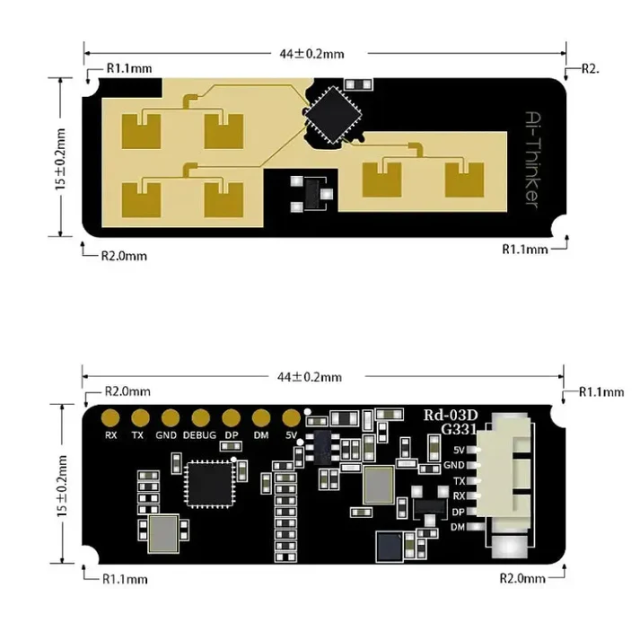1. Overview
In satellite and aerospace communication payloads operating above 30 GHz, PCB substrates must maintain exceptional dielectric uniformity and low-loss performance under extreme thermal and radiation conditions.
Ceramic PCB materials—such as alumina (Al₂O₃) and aluminum nitride (AlN)—are widely adopted due to their high dielectric constant, stable dissipation factor, and superior heat conduction.
KKPCB’s advanced RF ceramic process integrates metallized via structures, vacuum lamination, and ultra-flat surface control to ensure phase-linear signal transmission and minimal loss variation across wide temperature ranges.

2. Challenges in Aerospace RF PCB Design
The aerospace communication environment subjects RF hardware to severe vibration, temperature fluctuation, and radiation-induced dielectric drift.
Common engineering challenges include:
-
Maintaining insertion-loss stability across 20–50 GHz Ka-band frequencies
-
Preventing dielectric property drift under ±150 °C thermal cycling
-
Achieving consistent impedance within ±2 Ω tolerance across multilayer stackups
-
Managing heat dissipation in power amplifier and transceiver modules
Conventional PTFE or hydrocarbon substrates often fail to retain dielectric stability at altitude and temperature extremes, making ceramic PCB technology essential for reliable satellite operation.
3. Material and Dielectric Properties
KKPCB’s aerospace-grade Ceramic PCBs employ high-purity AlN or Al₂O₃ ceramics characterized by:
| Property | Al₂O₃ | AlN |
|---|---|---|
| Dielectric Constant (Dk @ 10 GHz) | 9.8 | 8.8 |
| Dissipation Factor (Df) | 0.0001 | 0.0002 |
| Thermal Conductivity | 24 W/m·K | 170 W/m·K |
| CTE (ppm/°C) | 6.5 | 4.6 |
These characteristics enable tight impedance control, low insertion loss (<0.1 dB/cm @ 40 GHz), and stable phase response, supporting satellite transceiver modules, LNAs, and phased-array antennas.

4. Case Study — Satellite Downlink RF Module
Client: European satellite integrator specializing in Ka-band payloads.
Objective: Improve signal integrity and dielectric stability in 40 GHz downlink front-end boards.
Engineering Process:
-
Material: AlN-based Ceramic PCB with 0.25 mm dielectric layer.
-
Copper Metallization: 18 µm sputtered + plated Cu for fine-line definition (≤ 75 µm).
-
Via Filling: Metallized through-ceramic vias for high thermal conductivity.
-
Validation: Vector network analyzer and thermal shock testing to 175 °C.
Results:
| Parameter | Requirement | Achieved |
|---|---|---|
| Insertion Loss | ≤ 0.12 dB/cm @ 40 GHz | 0.09 dB/cm |
| Phase Deviation | < 1° across –55 °C to +175 °C | 0.6° |
| Radiation Resistance | > 100 krad | Passed |
| Impedance Deviation | ±3% | ±1.8% |
KKPCB’s ceramic-based RF solution significantly enhanced phase coherence, power gain, and long-term dielectric consistency.
5. Stackup and Layout Implementation
The optimized 4-layer hybrid stackup combined:
-
AlN dielectric core for thermal and dielectric stability
-
Inner-layer Cu reference plane for return-path integrity
-
Gold-plated microstrip surface to reduce oxidation and maintain conductivity
-
Embedded cavity design for low-profile RF integration
Advanced impedance modeling and HFSS verification ensured accurate matching for Ka-band frequencies and reduced mode conversion between feed and antenna elements.
6. Reliability and Qualification Testing
| Test Item | Condition | Result |
|---|---|---|
| Thermal Cycling | –55 °C ↔ +175 °C, 1000 cycles | No delamination |
| High-Power RF Endurance | 10 W/cm², 48 h | Stable loss |
| Outgassing | < 1.0% (per ASTM E595) | Passed |
| Vibration | 20 G, 10–2000 Hz | No mechanical failure |
| Radiation Exposure | 100 krad (Si) | No Dk drift |
The ceramic substrate’s low CTE and radiation resistance make it ideal for long-duration missions where laminate-based materials would degrade.
7. Conclusion
Ceramic PCB technology provides a robust, low-loss, and thermally stable foundation for aerospace communication payloads.
KKPCB’s RF engineering and vacuum lamination processes ensure phase stability, radiation tolerance, and dielectric precision, supporting long-term reliability in satellite transceivers, radar sensors, and phased-array systems.
These performance advantages solidify Ceramic PCBs as the preferred substrate for next-generation spaceborne RF architectures.
8. Contact
Contact KKPCB’s Aerospace RF Engineering Division for technical consultation on Ceramic PCB stackup design, Ka/Ku-band signal validation, and satellite-grade reliability testing.

